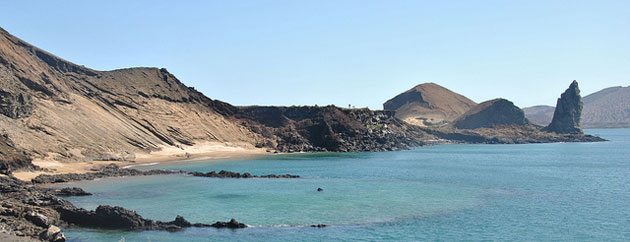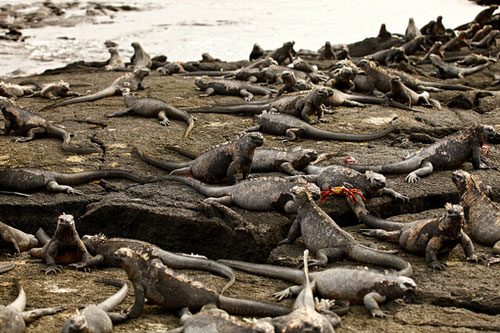
Tour the Galapagos: The World’s Most Untouched Islands
16 December, 2011In an effort to keep the natural environment healthy and thriving, only four of the Galapagos Islands are approved for residential living. Most of the islands are open to tourist traffic under the supervision of a Galapagos National Park naturalist. The Ecuadorian government has strict control over the number of annual visitors that are allowed to come to the islands. Privileged visitors come to this peaceful island chain straddling the equator for the pleasure of experiencing unique botanical finds, friendly engaging animals and crystal waters.
Pizarro banished a group of treasonous soldiers from the mainland in 1546. Drifting aimlessly in the current, eventually the soldiers saw the islands through a foggy mist. They dubbed the islands “Las Islas Encantadas”, because they appeared to be enchanted. During the foggy season an ethereal blanket distorts the shapes of creatures roaming freely just beyond your view. If unicorns do exist, it is easy to imagine this is their breeding ground. This is one place you can allow your imagination to roam as freely as the fearless creatures that inhabit the Galapagos Islands.
Excursion outfitters are available all year round, but you have to prepare yourself for possible detours along the way. Time moves at a different pace and the remote islands present challenges for operators and scheduling captains. Air service is limited and weather could delay arrivals. Visiting the islands on a Quasar Galapagos Expeditions cruise or with another Galapagos Tour operator is recommended.
Taking a tour of the Galapagos Islands is like stepping into an alternate time. The tourist industry has changed the landscape and the natural environment somewhat, but there is still a sense of ageless continuity. There are no indigenous people from the islands, but there is a remarkable history of temporary inhabitants through the centuries.
Historical Significance of Galapagos
Although some historians think Inca inhabitants of South America may have visited the islands, most records give Tomás de Berlanga credit for first documenting the chain of 18 islands and several smaller formations in the Pacific Ocean. When de Berlanga, the Bishop of Panama, and his crew were stranded on one of the islands in 1535, they thought the gigantes tortugas had shells that resembled saddles. Galapagos is the Spanish word for saddle.
De Berlanga sent a letter to King Carlos V describing the massive land animals and tame nature of the unique indigenous wildlife. He was not overly impressed by the gorgeous ocean, bountiful animal species, and lack of fresh water on the islands.
The islands have undergone numerous name changes over the years. A 16th century map labels the area as “Insulae de los Galopegos”. Each of the islands had an English name until the Ecuadorian government renamed them during the 1832 annexation.
Charles Darwin and Other Visitors
In 1835, Charles Darwin was only 22 years old when he remarked that the Galapagos Islands “seemed to be a little world within itself.” As a budding geologist, Darwin sailed aboard the British Beagle as a gentleman’s companion and shipboard naturalist. With limited experience, he planned to observe the volcanic activity and rock formations. He gathered flora and fauna for botanists, and bird, animal and sea-creature specimen for zoological classification. Darwin’s visits to the islands profoundly changed the direction of his life. To learn more about Darwin’s experiences visit Darwin online.
Pirates and profiteers often landed on the island at the mercy of calm seas and prevailing currents. There are stories of marooned sailors living on Galapagos for a few days and even a few years. Whaling ships often came into the area in search of the large turtles. The turtles can survive many months without food and water; therefore, they were an excellent source of fresh meat for sailors on long trips.
Interacting with Wildlife
The only true natives on the islands are animals. There is no other place in the world that you can share a beach with inquisitive sea lions and dozens of iguanas. The contrasts are stark. Amid an endless sea of brown motionless lizards basking in the mid-day sun, brilliant red crabs scurry over the sleeping bodies toward the sea. Beige, almost bland-bodied birds boast bright pink feet and beaks painted in vibrant blues and greens.

Whether you are scuba diving offshore or lounging in the sun, expect to be joined by at least one of the natives. Hiking with turtles, diving with sea lions and sunbathing with an iguana are all impromptu surprises as you explore the larger islands. You can design your own personal Galapagos charter.
Discovering the beauty of unique equatorial landscape
At first glance, it is difficult to imagine the lava formed lands could host so many different life forms. Naturalists are drawn to tiny plants amid the jagged terrain. Visit during flowering season and you will see hundreds of botanical delights. The flora resembles scraggly weeds from a distance, but up close the delicate petals and spiny stems take on a miraculous transformation.
Hikers exploring the higher elevation areas will find moss draping the tall shrubs, rocks and cliffs. Adventurous hikers will find cactus an excellent source of hydration and nourishment — remember to pack leather gloves to protect your hands from the thorns.
Numerous volcanoes are still erupting and adding new land mass. La Cumbre on Fernandina is the most active volcano in the region. The last known eruption was in 2009. With a summit elevation of 4842 feet, this volcano has a deep summit caldera. Aerial views are spectacular. There are currently no aerial tours allowed on the islands, but Galapagos tours by boat give some excellent views of the shoreline and provide day-trips on land.
Make it a working vacation
You might consider working on a 50-hectare farm on San Cristobal Island. This small community gives volunteers a chance to help reclaim areas impacted by invasive plant species. The landscape includes arid lowlands and moist upper regions. Higher elevations reveal the dense miconia zone, with a lush belt of shrubbery and ferns.
Volunteers stay from 1 week to 12 weeks. Time spent with local children and families hiking, horseback riding and playing games is an educational opportunity to share ecological information with the local residents. To learn more visit: ecovolunteerup.org.
Something for everyone in the Galapagos
Snorkelling, hiking, horseback riding, rafting and canoeing are within easy access. Exploring the National Park and visiting the Darwin Science Center offer opportunities to learn more about the history of the Galapagos and the expansive endemic animal population.
Touring the islands by cruise liner is an excellent way to get a view of the island chain. There are two airports and hotels are available on the four largest islands. Darwin was right; the Galapagos Islands are a magical “little world within itself”.
Follow Sounds and Colours: Facebook / Twitter / Instagram / Mixcloud / Soundcloud / Bandcamp
Subscribe to the Sounds and Colours Newsletter for regular updates, news and competitions bringing the best of Latin American culture direct to your Inbox.

